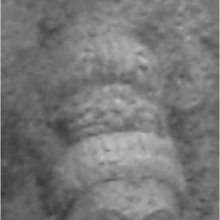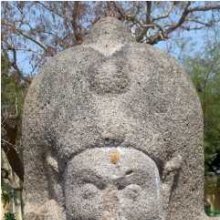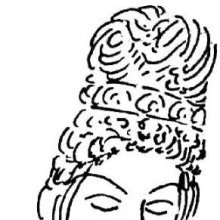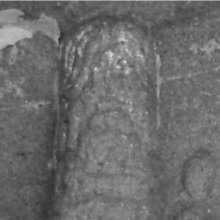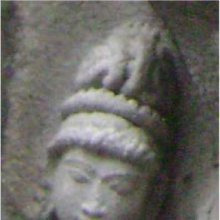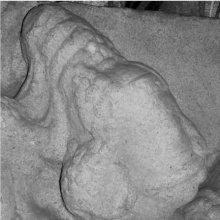Jatamakuta, Jaṭāmakuṭa, Jata-makuta: 5 definitions
Introduction:
Jatamakuta means something in Buddhism, Pali, Hinduism, Sanskrit. If you want to know the exact meaning, history, etymology or English translation of this term then check out the descriptions on this page. Add your comment or reference to a book if you want to contribute to this summary article.
Images (photo gallery)
(+9 more images available)
In Hinduism
Shaktism (Shakta philosophy)
Source: Google Books: ManthanabhairavatantramJaṭāmakuṭa (जटामकुट) (Cf. Jaṭāmukuṭa) refers to “one adorned with matted hair and a crown”, according to the Tantrasadbhāva, an important Trika Tantra and a major authority for Kashmiri Trika Śaivites.—Accordingly, while describing Raudrī (Rudraśakti): “She is beautiful and has beautiful breasts. She has two arms and three eyes and is endowed with all the ornaments. She is adorned with matted hair and a crown [i.e., jaṭāmakuṭa maṇḍitā]. She holds a skull in her left hand that is filled with nectar. Adorned with necklace and anklets, one should think of her as devoted to eating and drinking”.

Shakta (शाक्त, śākta) or Shaktism (śāktism) represents a tradition of Hinduism where the Goddess (Devi) is revered and worshipped. Shakta literature includes a range of scriptures, including various Agamas and Tantras, although its roots may be traced back to the Vedas.
Shaivism (Shaiva philosophy)
Source: Brill: Śaivism and the Tantric TraditionsJaṭāmakuṭa (जटामकुट) refers to “matted locks”, according to the Kiraṇatantra chapter 49 (dealing with vratacaryā).—Accordingly, “Garuḍa spoke: ‘You have taught me, O great Lord, the activities of the Neophyte, the Putraka and the Ācārya. Tell me those of the Sādhaka’. The Lord spoke: ‘[...] This is the auspicious Raudra-vrata: imposing with a chignon of matted locks (jaṭāmakuṭa-sāṭopa), marked by a trident and khaṭvāṅga, equipped with a clean half skull, awe-inspiring with a third eye, clothed in the skin of a tiger, peaceful. For one firm [in this observance], the highest siddhi will arise in six months; middling [powers] in four months; the lowest [powers] will arise in three months. [...]’”.

Shaiva (शैव, śaiva) or Shaivism (śaivism) represents a tradition of Hinduism worshiping Shiva as the supreme being. Closely related to Shaktism, Shaiva literature includes a range of scriptures, including Tantras, while the root of this tradition may be traced back to the ancient Vedas.
In Buddhism
Tibetan Buddhism (Vajrayana or tantric Buddhism)
Source: Brill: Śaivism and the Tantric Traditions (tantric Buddhism)Jaṭāmakuṭa (जटामकुट) refers to “having braids of hair as a crown”, according to the Nāmamantrārthāvalokinī by Vilāsavajra, which is a commentary on the Nāmasaṃgīti.—Accordingly, [while describing Mahāvairocana]—“And then [the Sādhaka should visualise] Mahāvairocana on the principal seat, generated by means of the syllable āḥ. [...] He is white in colour because he has the Dharma-Sphere as his nature. He has braids of hair [stacked up on his head] as a crown (jaṭāmakuṭa-upeta) and is unadorned because he is one whose mind is tranquil. Since he has both wisdom and means as his nature he makes the bodhyagrī (“highest awakening”) hand gesture”.
Source: OSU Press: Cakrasamvara SamadhiJaṭāmakuṭa (जटामकुट) refers to “(possesing) a crest of dreadlocks” which is used to describe Cakrasaṃvara, according to the Saṃvaramaṇḍala of Abhayākaragupta’s Niṣpannayogāvalī, p. 45 and n. 145; (Cf. Cakrasaṃvaratantra, Gray, David B., 2007).—Accordingly, [while describing the iconography of Cakrasaṃvara]: “In the Saṃvara Maṇḍala atop Mount Sumera within a vajra-canopy there is a variegated lotus, on top of that a palace, in the middle of which is the Blessed Lord, standing in ālīḍhāsana, "archer's pose", [...] possessing a naraśiromālā-śatārdha, "garland of fifty (fresh) human heads" around the neck, the ṣaṇmudrā, "six insignia", bone ornaments, which are the kaṇṭhikā, "necklace", rucaka, "bracelets", kuṇḍala, "ear-rings", mekhalā, "girdle", śiromaṇi, "crest jewel", and bhasmitiḥ, "covered in ashes", a jaṭāmakuṭa, "crest of dreadlocks", kapālamālā, "crown of (five) skulls", topped by an ardhacandra, "crescent moon", and viśvavajra, "world vajra" or "double vajra", a vikṛitānana, "fierce face", and daṃṣṭrotkaṭa, "horrible gigantic fangs".
Note: The crest of dreadlocks (jaṭāmakuṭa) symbolizes the generation and accumulation of puṇya, "merit" to the fullest measure.
Source: MDPI Books: The Ocean of HeroesJaṭāmakuṭa (जटामकुट) refers to a “crown of twisted locks of hair (on the face)”, according to the 10th-century Ḍākārṇava-tantra: one of the last Tibetan Tantric scriptures belonging to the Buddhist Saṃvara tradition consisting of 51 chapters.—Accordingly, “[...] [The Causal Vajra-holder] is white in color, [has] four faces, [has] three eyes [on each], [has] twelve arms, is devoted to the yoga of union with wisdom (his female consort), and is adorned with youthful ornaments. [His four faces are], counterclockwise, white, green, red, and yellow [in color, respectively]. [He has] twisted locks of hair (mukha-jaṭāmakuṭa) and has a crossed vajra and a crescent moon on the face (head). [...]”.

Tibetan Buddhism includes schools such as Nyingma, Kadampa, Kagyu and Gelug. Their primary canon of literature is divided in two broad categories: The Kangyur, which consists of Buddha’s words, and the Tengyur, which includes commentaries from various sources. Esotericism and tantra techniques (vajrayāna) are collected indepently.
See also (Relevant definitions)
Partial matches: Makuta, Jata.
Full-text (+26): Makuta, Jata, Maheshvari, Ekanetra, Ishana, Mekhala, Kundala, Rucaka, Siromani, Kanthika, Ekarudra, Narashiras, Shiromala, Murtyashtaka, Shatardha, Narashiromala, Sumitra, Kapalisha, Devadeva, Shanmudra.
Relevant text
Search found 7 books and stories containing Jatamakuta, Jaṭāmakuṭa, Jata-makuta, Jaṭā-makuṭa; (plurals include: Jatamakutas, Jaṭāmakuṭas, makutas, makuṭas). You can also click to the full overview containing English textual excerpts. Below are direct links for the most relevant articles:
Head-Gears in Hindu Art < [March 1937]
Architecture And Temple Construction < [January 1958]
The Golden Age of Hindu-Javanese Art < [September-October 1931]
The Religion and Philosophy of Tevaram (Thevaram) (by M. A. Dorai Rangaswamy)
Nayanar 51: Vayilar < [Volume 4.1.1 - A comparative study of the Shaivite saints the Thiruthondathogai]
The various sects of Shaivism < [Volume 2 - Nampi Arurar and Mythology]
Chapter 4.6 - (l) Shiva’s ornamentation < [Volume 2 - Nampi Arurar and Mythology]
Pallava period (Social and Cultural History) (by S. Krishnamurthy)
Coiffure of Men < [Chapter 4 - Material Culture of the People]
Head-dress of Men (Crowns) < [Chapter 4 - Material Culture of the People]
Head-dress of Men (Tiara) < [Chapter 4 - Material Culture of the People]
Later Chola Temples (by S. R. Balasubrahmanyam)
Temples in Nidur < [Chapter II - Temples of Kulottunga I’s Time]
Temples in Melakkadambur < [Chapter II - Temples of Kulottunga I’s Time]
Temples of Munnur (Historical Study) (by R. Muthuraman)
Vietnamese Buddhist Art (by Nguyen Ngoc Vinh)
3. Avalokitesvara images in Funan < [Chapter 3 - Unifying factors of the Avalokitesvara Images in South Vietnam and South East Asia]
